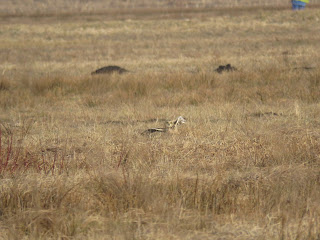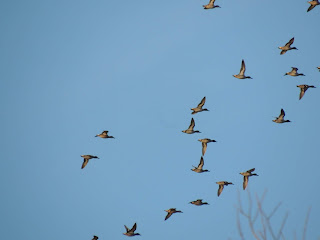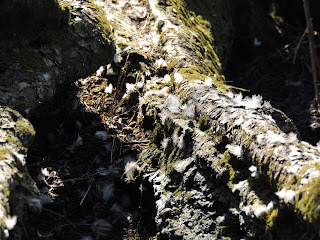Marsikdo med vami, vdanimi bralci, je nemara že zapozabil na dejstvo, da so hladne poplave v februarju oblile puste, osivele barjanske travnike. Mi seveda nismo in smo vodnato področje še enkrat obiskali, da bi obeležili ptičji živelj, ki je tja jel položiti svojo pernato rit.
Plitva mlakuža s travnato preprogo namesto dna je privlačna destinacija za plojkokljune vseh sort in oblik, ne glede na letni čas. To z letnim časom sicer ni čisto res, pa vendar! V preteklem tednu je vodna gladina od nivoja, ki smo ga ukoristili za pohod s čolnom, upadla za obilen meter, zato se je razpoložljiva akvatična površina skrčila na nekaj ubornih, ped ali dve globokih mlakuž. To je za račjo druščino morda slabo, zato pa je toliko bolje za nas in številne lakomne plenilce, ki radi oblegajo jate vodnih ptic.
Na usahli vodi se je torej pozibavalo:
40 labodov grbcev (Cygnus olor)
3 beločele gosi (Anser albifrons)
170 kreheljcev (Anas crecca)
3 žličarice (Spatula clypeata)
5 žvižgavk (Mareca penelope)
1 konopnica (Mareca strepera)
100 mlakaric (Anas platyrhynchos)
5 dolgorepih rac (Anas acuta)
1 duplinska kozarka (Tadorna tadorna)
Morda bi se kdo usodil reči: ježeš, ta nabor sploh ni nič posebnega - morda sicer vključuje vse mareca in spatula, ne pa tudi vseh anas rac! A svet je neizprosen in ne glede na lokalna osebna prepričanja posameznih telohov in trobentic je še vedno februar.
Pretekli teden je bila na Barju tudi drugič v zgodovini ubadanja s selečimi racami preizkušena tehnika skrivanja v vegetaciji, tokrat žal na primerku vrbe namesto koruze. Vrbino grčasto deblo je mojo pojavo prikrilo škiljavim kreheljcem in na mlakarico navezani duplinski kozarki, zato fotografije to pot, dasiravno so še vedno slabe, vendarle vsebujejo kakšen piksel več kot običajno. Moj v pulover oviti život pa je ostal neviden tudi drugim pticam, denimo krvoločnemu kragulju (Acipiter gentilis), ki je meni nič tebi nič švignil mimo mojih ušes in se v nizkem letu zapodil med kreheljce, ki sem jih bil ravno fotografiral. Nekulturen uboj kreheljca ni ostal neopažen in vsi, od njegovih sestričen do gosi in obilnih labodov, so se razbežali (glej sliko). Kragulj je kreheljca trudoma zvlekel iz vode do travnatega roba, kjer ga je, prikrit z zlatorjavimi bilkami, konzumiral.
Ker je svet vendarle tudi prijazen, se je iz blatnega dremeža prebudila tudi želva (Emys orbicularis), ki se je togotno sončila na blatnem bregu in je bila mojim pričakovanjem navkljub že preveč vibrantna za fotografski posladek, saj je spolzko zdrknila v zeleni kanal.
Common Teal are at the moment probably the most abundant duck species in Ljubljansko barje.
A flock of Greylag geese, here mixed with the first Teal, present only a few days after the heavy rain
Luka is utterly unaware of his charms, that do not go unnoticed by the wary cow
As always, floods attracted a black form of Crows. Usually, the floods would be visited by Carrion Crows, but this time, we had an honour to observe a flock of Rooks!
A juvenile Rook, a bit more difficult to ID
Unmistakable mature Rook, compared to Hooded Crow on the left.
An unlucky Coypu.
An unhappy Coypu.
A nest of House Mice, taking shelter under the wood floor of an abandoned house.
A Great-spotted Woodpecker found himself an acorn!
Infiltrated tiny ducks.
Scattered groups of Teal - males are already beautifully coloured and ready for spring.
Nothing makes the duck migration feel as alive as an extremely nervous Teal flock.
The only type of corn field we approve ...
... covered with a biofilm of adorable ducks.
Swans swarm to the floods from nearby lakes and rivers - we can only hope they fail to get malnourished due to the lack of white bread, thrown at them by children and old ladies.
A sharp eye can detect male Wigeons, mixed in the mass of Teal and Mallards.
A sharper eye may also detect a few extremely early migrating Shovelers! Interesting observation.
Even pleasant looking Pintail couples can be seen, regardless of the date.
The sharpest of eyes may even detect another duck species in this photograph ... what could it be?
Indeed it is a guest star - who would say, that Shelducks fly over Ljubljana basin in February. Lucky for them, we are blessed with sufficient amount of habitat this year. Enjoy your stay!
Looking closely to the picture, one might sense a sort of a disturbance in the Force.
Note the panicking Swans and the intense fear among the Teal - it was all caused by a male Goshawk, that flew into the peaceful flock and killed one of the Teal.
Panic is real as Swans, Ducks and Geese alike are abandoning the pool.
After killing the duck, the bird of prey pulled its victim to the nearest dry land. As the Goshawk could not take flight with the prey directly from the water, it dragged the body to the shore with awkward jumps, using its wings to push ahead and stay on the water surface.
Red and cruel eye of the Goshawk is scanning the surroundings.
A poor crop of a clip reveals the unlucky dead duck.
The Goshawk secures the prey by covering it with his broad wings.
Common Raven declares this event to be sad.
A random Roe Deer
A romantic photograph of Mute Swans to lighten the mood after seeing the death of an innocent Teal.
A Mute Swan is interrupting an incredible sight - this is the first decent photograph of seated White-fronted Geese in Barje.
Airborne White-fronted Goose
This may look like dandelion seeds, but in fact this is a meadow, covered in duck feathers after the retreat of the water.
A load of fluff, deposited on a fallen tree-trunk, that ducks used for sleeping in the time of floods.
A case of an identified feather of a male Teal.
A case of an identified feather of the Shelduck.
Small groups of here poorly visible Stock Dove contribute to a springy vibe.
LP, Matija






































































